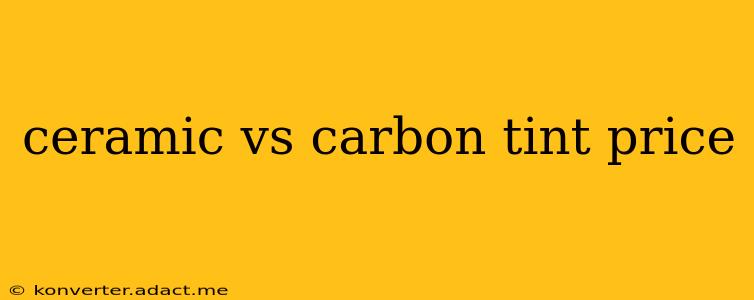Choosing between ceramic and carbon window tint can be tricky, especially when considering the price difference. Both offer significant benefits over standard dyed films, but their composition and performance characteristics lead to varying costs. This article will break down the price differences, highlight key features, and help you determine which type of tint is the best investment for your needs.
What Affects the Price of Window Tint?
Before diving into a direct ceramic vs. carbon tint price comparison, it's important to understand the factors influencing the overall cost. Several elements contribute to the final price tag:
- Type of film: As we'll explore, ceramic and carbon films differ significantly in their manufacturing processes and materials, resulting in different price points.
- Film quality: Higher-quality films utilize superior materials and advanced technologies, leading to better performance and a higher price. Look for warranties as an indicator of quality.
- Vehicle size: Larger vehicles naturally require more film, increasing the total cost of installation.
- Number of windows: Tinting more windows (e.g., sunroof, rear windshield) adds to the labor and materials costs.
- Installer expertise: Experienced and reputable installers often charge more, but their expertise ensures a professional, high-quality installation.
- Location: Labor and material costs vary geographically.
Ceramic Tint Price
Ceramic tint generally sits at the higher end of the pricing spectrum. While precise pricing varies widely based on the factors mentioned above, you can expect to pay a premium compared to carbon tint or standard dyed films. The superior heat rejection and UV protection offered by ceramic tint justify the higher cost for many consumers.
Why is Ceramic Tint More Expensive?
Ceramic tint's higher price is a direct result of its manufacturing process. It uses ceramic nanoparticles in its composition, making it more complex and costly to produce. These nanoparticles are responsible for its excellent heat rejection properties without compromising visible light transmission (VLT).
Carbon Tint Price
Carbon tint typically falls in the mid-range price bracket. It offers a good balance between cost and performance, making it a popular choice for many drivers. While not as effective at heat rejection as ceramic, it still provides notable improvements over standard dyed films.
Why is Carbon Tint Less Expensive?
Carbon tint utilizes carbon-based materials in its construction. This manufacturing process is generally less complex and less expensive than the one used for ceramic tints. Therefore, the end product is typically more affordable.
Comparing Ceramic and Carbon Tint: Key Differences
| Feature | Ceramic Tint | Carbon Tint |
|---|---|---|
| Price | Higher | Lower |
| Heat Rejection | Excellent | Good |
| UV Protection | Excellent | Good |
| Signal Interference | Minimal to None | Minimal, but potentially more than ceramic |
| Durability | Generally High | Generally High, but may fade slightly over time |
| Appearance | Often a clearer, more natural appearance | Can have a slightly darker, more metallic look |
What are the differences in performance?
Both ceramic and carbon tints offer significant improvements over standard dyed films, but their performance varies. Ceramic typically provides superior heat rejection, UV protection, and often clearer visibility. Carbon provides a good balance of performance at a more affordable price, although its heat rejection properties might be slightly less effective.
Which Tint is Right for Me?
The "best" tint depends entirely on your priorities and budget. If superior heat rejection and UV protection are paramount, and price is less of a concern, ceramic tint is the better choice. However, if you're seeking a balance of performance and affordability, carbon tint might be a more suitable option.
Frequently Asked Questions (FAQs)
How long do ceramic and carbon tints last?
Both ceramic and carbon tints are designed to be durable, lasting several years. However, their longevity can vary depending on factors like the quality of the film, proper installation, and environmental conditions. Most reputable installers offer warranties to reflect their confidence in the tint's durability.
Do ceramic and carbon tints affect GPS or radio signals?
High-quality ceramic and carbon films are designed to minimize interference with GPS and radio signals. However, some cheaper options might cause slight interference.
Can I install window tint myself?
While DIY window tint kits exist, professional installation is highly recommended. Professionally installed tint ensures a flawless, bubble-free application and is usually covered by a warranty. Improper installation can lead to peeling, bubbling, or other problems that compromise performance and appearance.
This comprehensive comparison should provide you with a clearer understanding of ceramic vs. carbon tint, allowing you to make an informed decision based on your individual needs and budget. Remember that obtaining multiple quotes from reputable installers in your area will help you determine the precise pricing for your vehicle.
